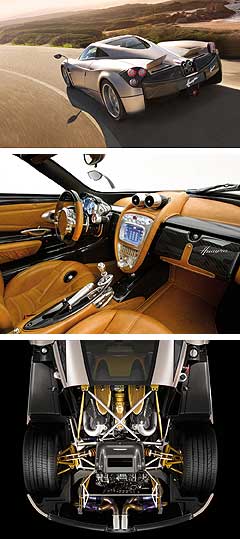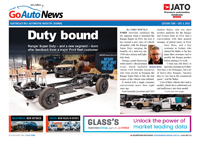Make / Model Search
Future models - Pagani - HuayraGeneva show: Pagani unveils Zonda supercar successorLift off: The Pagani Huayra is set to be unleashed on Geneva. Stunning gullwinged Huayra emerges as Pagani’s long-awaited all-new supercar27 Jan 2011 By TERRY MARTIN PAGANI has revealed its long-awaited successor to the ultra-high-performance million-dollar Zonda, releasing images and the first tantalising specifications for its awesome new gullwing supercar known as Huayra. A nameplate meaning ‘god of the wind’, Huayra (pronounced ‘why-ra’) continues Pagani’s alliance with Mercedes-AMG, foregoing the Zonda’s AMG-sourced 7.3-litre V12 for a twin-turbocharged 6.0-litre ‘M158’ V12 that was first seen in Mercedes’ 2008 SL65 AMG Black Series but, for this application, has received specifically designed heads, pistons, turbos and exhaust manifolds from AMG. GoAuto understands there will be two levels of turning for the engine, a base 700hp (522kW) and 900Nm version and a Sport grade with an extra 30hp (taking it to 544kW) and 200Nm – the latter taking it to an even higher ‘torquing’ point of 1100Nm. These are still preliminary figures, according to Pagani, but the Italian supercar marque has made it clear that Huayra – despite being bigger than the Zonda – will improve on its predecessor in the performance benchmarks, with the new-generation coupe (dry weight: 1350kg) reportedly accelerating from 0-100km/h in 3.3 seconds. Mounted behind the seats, the engine drives the rear wheels through a transverse-mounted sequential seven-speed gearbox with paddle shifters and a dual-plate clutch. Pagani says a dual-clutch system was evaluated “but ultimately not selected as it would have increased the weight by approximately 70kg, thus negating any minor improvement in shift-time”. The Huayra’s Xtrac-developed gearbox weighs just 96kg. The performance claims place the Huayra three tenths of a second faster than the 2005 Clubsport-spec Zonda F, although not quite as ballistic as the wild 2009 Zonda R ultra-lightweight (1079kg dry) track special, which employed AMG’s race-derived ‘M120’ 6.0-litre dry-sump V12 (producing 551kW/710Nm) and could hit 100km/h from standstill in an even more eye-watering 2.7 seconds.  Horacio Pagani is, however, quick to point out that the Huayra – developed under the codename C9 over the past seven years – was not designed and engineered as a Zonda clone. Horacio Pagani is, however, quick to point out that the Huayra – developed under the codename C9 over the past seven years – was not designed and engineered as a Zonda clone.It was also developed with more safety technology than Zonda, and to ensure it passed homologation requirements for sale in the US, which will be a first for the brand. “Since the original design of the Zonda was done in the early ’90s, the first thought was that it was now an obsolete project and we decided to imagine the car totally different in form, dimension, dynamics and technology – all this without losing the essence of our approach,” he said. “The eternal element air in all its forms, especially wind, became determining in defining the concept and it was a great inspiration, as it is ever present in our lives: a jet turbine, the silence of a glider... the elegance of the movements the wind creates, but also the violence and force that it can unleash.” Mr Pagani said that in defining the size of the new vehicle, he wanted it longer than the Zonda, with a wider track, a more spacious cabin (with the seating position pushed back a little) and, overall, with a silhouette that would be “soft, easy to read and form itself from lean and sleek lines that have a clear beginning and an end”. He also said that over the course of its development, new Zonda editions became crucial test cars, of a sort, for the C9, and that the Zonda R in particular was a “key laboratory” for the Huayra. “The team was able to work on many projects at the same time driving on different tracks that occasionally came to meet by sharing engineering concepts, materials, safety and scientific or design studies,” he said. The Huayra measures 4605mm in overall length, 1169mm in height and 2036mm in width. Weight distribution is 44 per cent front and 56 per cent rear, with the bodywork (including the doors) made from carbon-fibre. The monocoque chassis is made from carbon-titanium. Aerodynamics inspired by an aircraft wing played a major part in the design evolution, not simply in the flowing shape but also specific aviation tools, such as moveable flaps at each corner of the car that are independently and automatically operated. Combined with ‘active front suspension’ which allows for the ride height to be adjusted, Pagani claims the four flaps have allowed it to “optimally balance” the vehicle’s drag coefficient and downforce. According to Pagani, the goal was to have neutral vehicle behaviour under all conditions and tight rein over bodyroll via aerodynamic means rather than electronic intervention. It says the behaviour of the flaps is managed by a dedicated control unit that is fed information from the ABS and ECU, which pass information about the car’s speed, yaw rate, lateral acceleration, steering angle and throttle position. The cabin is instantly recognisable as a Pagani and virtually all primary functions for controlling the vehicle are positioned on the steering wheel. While there are plenty of mod-cons onboard, as evidenced by an advanced infotainment system operated via a high-definition central touch-screen, the Italian designers have also placed an emphasis on a “living, breathing” atmosphere rather than an overtly digital one. The company points to aspects such as leather latches, use of toggle switches, a mechanical aluminium gearlever and an aluminium dash that takes inspiration from Swiss watch designs. Further details, including production and release dates, are expected when the Huayra makes its public debut at the Geneva motor show on March 1.  Read moreAll future modelsMotor industry news |
Click to sharePagani modelsAll future modelsMotor industry news |



 Alfa Romeo
Alfa Romeo Abarth
Abarth Audi
Audi Aston Martin
Aston Martin BMW
BMW Bentley
Bentley Ferrari
Ferrari Chevrolet
Chevrolet Ford
Ford Fiat
Fiat GWM
GWM Foton
Foton Hyundai
Hyundai Honda
Honda Jaguar
Jaguar Isuzu
Isuzu Kia
Kia Jeep
Jeep Land Rover
Land Rover Lamborghini
Lamborghini Maserati
Maserati Lexus
Lexus McLaren
McLaren Mazda
Mazda Mercedes-Benz
Mercedes-Benz Mitsubishi
Mitsubishi Mini
Mini Peugeot
Peugeot Nissan
Nissan Ram
Ram Porsche
Porsche Rolls-Royce
Rolls-Royce Smart
Smart Skoda
Skoda Suzuki
Suzuki Subaru
Subaru Toyota
Toyota Tesla
Tesla Volvo
Volvo Zeekr
Zeekr







Facebook Twitter Instagram